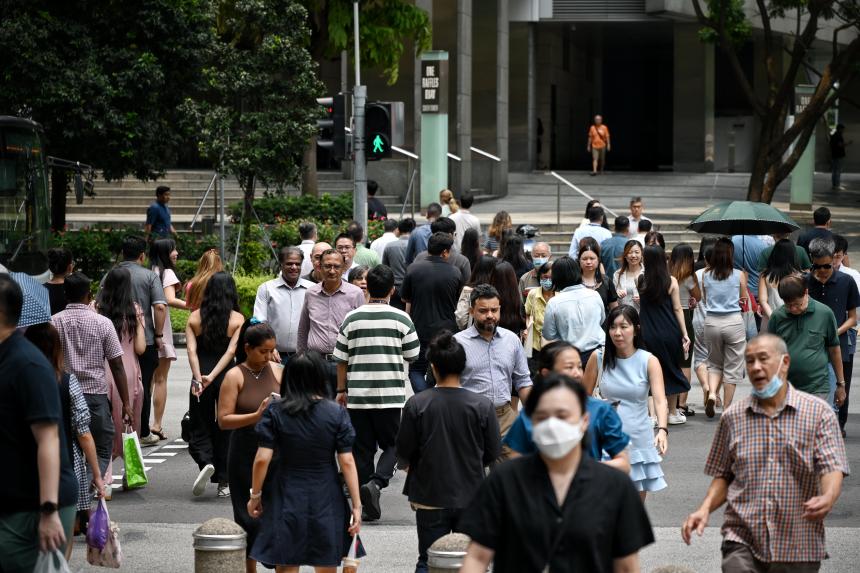SINGAPORE – Retrenchments in Singapore fell for the second straight quarter while the hiring outlook improved, according to preliminary first-quarter labour market data released by the Ministry of Manpower (MOM) on April 30.
The data also showed that total employment grew by 4,900 in the January to March quarter, down from 7,500 in the previous quarter.
The growth came wholly from Singaporeans and permanent residents (PRs).
At the same time, non-resident employment contracted for the first time since the third quarter of 2021 due to cooling labour demand, mainly in construction as tighter foreign worker quotas kicked in.
Although the growth in total employment dropped, MOM said it was higher than in the previous quarters in 2023 – and comparable with growth in non-recessionary periods.
It also noted that applications for higher-skilled non-residents like Employment Pass holders have picked up in tandem with improved business expectations.
Retrenchments in the first quarter fell to 3,000 from 3,460 in the fourth quarter of 2023.
MOM said business reorganisation or restructuring remained the top reason for retrenchments in the first quarter of 2024, as businesses pressed on with transformation efforts.
It said the Singapore economy is expected to improve in 2024 and “labour demand, which tends to lag (behind) economic growth, should strengthen correspondingly”.
MOM said its forward-looking polls suggest stronger hiring demand, with 50.7 per cent of companies indicating an intention to hire in the next three months.
This is up from 47.7 per cent in the previous quarterly survey.
However, wage improvements could slow, as the proportion of companies with an intention to raise wages declined from 32.6 per cent to 26.1 per cent, the ministry noted.
MOM said the increase in resident employment was mainly in growth sectors such as financial services and health and social services, as well as public administration and education.
“Employment growth in these sectors outweighed the seasonal declines in retail trade, food and beverage services, and accommodation following the end of the festive period,” it noted.
The dip in non-resident employment was found mainly in the construction sector, in which most of the decline was among work permit holders.
MOM noted that employment in the sector fell for the first time since the fourth quarter of 2021, as construction companies adapted to the Jan 1 reduction in the sector’s foreign worker quota.
Smaller declines were also seen in outward-oriented sectors such as manufacturing, and information and communications, it added.
Unemployment rates edged up slightly in March 2024 to 2.1 per cent overall, 3 per cent among residents (citizens and PRs) and 3.1 per cent among Singaporeans.
But MOM said the figures remained within the range observed during non-recessionary periods.
It also said the increase was not unexpected, noting it had previously highlighted that unemployment rates could edge up amid higher retrenchments in the third and fourth quarters of 2023.
Companies that laid off workers in the fourth quarter included Asia Pacific Breweries Singapore, maker of Tiger Beer.
“However, we do not expect sustained increases in unemployment rates, given continued labour market tightness,” MOM said.
Finalised data for the quarter is due for release in mid-June and will provide more details such as the breakdown of resident and non-resident employment, sectoral statistics, the number of job vacancies, labour turnover, and re-entry rates among retrenched residents.
DBS Bank economist Chua Han Teng noted the decline in retrenchments was driven mainly by electronics manufacturing and wholesale trade.
However, hiring remains weak in the outward-oriented manufacturing sector, he added.
“In our view, the lack of new near-term hiring was probably due to the uneven recovery and lingering global uncertainties that kept manufacturers cautious.”
He also said the mixed data seen in MOM’s forward-looking polls indicate Singapore’s businesses appear to be adopting a cautious stance in the near term.
“We expect Singapore’s real GDP (gross domestic product) growth to recover to 2.2 per cent in 2024, from 2023’s muted 1.1 per cent, driven by external-led sectors, which would boost employment growth in the second half of 2024.”


